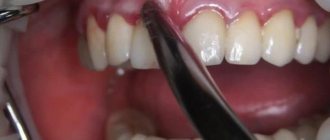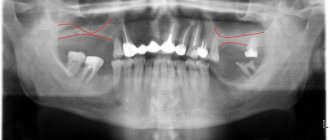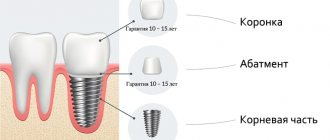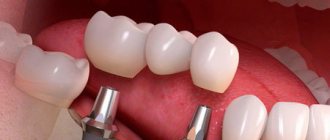To understand postoperative sutures, you first need to understand what osteoplasty is and one of its types - sinus lifting. Osteoplasty is a surgical intervention in which bone tissue grows at the site where there was a decrease in bone volume and/or injury. Most often, osteoplasty is performed during dental implantation. And the sooner bone plastic surgery is performed after tooth extraction, the better the recovery effect will be and the easier the preparation for manipulation will be. The following types of osteoplasty are distinguished:
- Osteoplasty affecting the mandibular bone in its lateral parts;
- Osteoplasty affecting the maxillary bone and its alveolar process;
- Osteoplasty affecting the maxillary bone in its lateral parts, or sinus lifting
Osteoplasty of the lateral sections of the manidibular bone is used in cases where the width and length of the alveolar processes decrease and the distance to the mandibular canal decreases. If the amount of bone tissue there decreases significantly, this will lead to malocclusion, of the mesial type.
Osteoplasty on the alveolar process of the maxillary bone is associated primarily with the splitting of bone tissue and the subsequent formation of a sharp, fragile, thin alveolar ridge. The main difficulty of this operation is to achieve the most beautiful cosmetic effect.
Sinus lifting is currently the most popular type of osteoplasty, and is called so because the operation is performed in the area of the sinuses or maxillary sinuses. It is carried out according to the closed and open type, and the process differs only in the method of introducing the implant into the site of future tissue growth.
Implantation options
In fact, implantation is performed in two variations of the development of the situation: after tooth extraction or as usual.
When you plan to install a Prodigy implant after tooth extraction, there is no need to cut into the gum. Because the hole for installing the implant is already ready and the working area for implanting the structure is available. A soft tissue incision will still be made, but only after healing to install the upper part of the tooth.
With the second option, the surgeon will have to make an incision twice, i.e. the first time for implantation of the Straumann implant, the second time when it is necessary to place a crown.
Wounds must be sutured after the operation is completed for proper and prompt healing of the damaged mucosa. The material for suturing has durable synthetic fibers that are resistant to damage, salivary fluid and other substances that enter the oral cavity during eating and drinking.
When, after how long and how to remove
The sutures are removed after the tissues have fused, on average 10-14 days. Sometimes healing takes three months because complications arise or the patient does not follow the doctor’s recommendations.
Dentists usually choose a thread that dissolves on its own, but sometimes they use regular medical thread, which requires removal.
The procedure looks like this:
- The entire cavity in the mouth is treated with an antiseptic to prevent infection by various infections.
- The thread is cut on one side, and the remaining material is pulled out on the other side with tweezers. The condition of the scar is first checked.
- After removing the threads, the patient rinses his mouth with an antiseptic.
Whether it hurts to remove stitches depends on the person’s pain threshold and the doctor’s actions. It usually feels like a slight tingling sensation. The feeling of discomfort will persist throughout the day.
However, there are cases when you should urgently consult a doctor:
- the pain persists for 3 days.
- the stitching site swells, hurts and bleeds.
If the doctor performed the operation correctly and without complications, the feeling of discomfort and discomfort lasts for a month. Every day this discomfort becomes less and less.
Possible complications
The situation when postoperative sutures come apart is quite rare. But if this happened, it means that certain factors accompanied it:
- The anatomical structure of cells - every patient has this feature of the body. The cells of the soft tissue mucosa are individual for each person. Such a factor cannot be foreseen or excluded in advance. For example, there are people whose banal scratch heals almost instantly, and there are those who suffer from this problem for weeks.
- Doctor's mistake - poor quality suture. Synthetics are an elastic material, and in places where the knots are weak, the thread cannot fix the required position. In addition, with surface pinching, when the epithelial layer is captured, the fabric can push the thread to the surface.
- Failure to comply with the doctor’s recommendations - poor care of the oral cavity and gums, poor nutrition, increased load on the installed Adin implant, as a result, the seams come apart.
- Illiterate preparation for surgery - lack of proper sterility due to poor-quality antiseptic treatment, can become a reason for the development of infection in the inner part of the working area.
Causes of seam divergence
As with any surgical procedure, complications are possible. One of them is the divergence of the seams, which threatens the development of inflammation. Often the patient himself is to blame for this because he did not follow the doctor’s recommendations, but there are other factors.
Here are some reasons why the sutures on the gums come apart:
- The patient did not follow the dentist’s advice, for example, he did hygiene procedures incorrectly, chewed on the side where the wound was, ate solid food, etc.;
- Doctor error, for example, superficial application or insufficiently tightened knots, which leads to poor fastening of the gum flaps;
- Inflammation due to insufficient sterility of surfaces and instruments, lack of preparation for the implantation procedure;
- Individual intolerance to ligamentous material, different rates of wound healing;
- Low quality material (this doesn’t happen often, but it does happen);
- Significant damage to the operated area or the entire jaw.
If the seam comes apart, you should absolutely not self-medicate! This can lead to serious inflammation, which can result in implant failure.
Service life of implant parts with proper care
After surgery, redness, slight bleeding and swelling at the implant site are normal. The pain will be felt for 4-7 days and should gradually subside. But the following symptoms should alert you:
- The swelling does not go away after a week (usually on the third day the swelling becomes most pronounced) and is accompanied by blue discoloration of the gums;
- The pain does not subside, but rather increases; anesthetics do not help;
- Although in the first two to three days there may be a slight temperature (up to 37.5 degrees), its rise in the following days will be a signal of inflammatory processes;
- Bleeding does not go away on the tenth day, or already on the first day there is an abundant outflow of blood from the wound.
If these symptoms begin to appear, you should consult a doctor immediately! This will help avoid inflammatory processes that can lead to divergence of the seams on the gums.
Cases of suture dehiscence after implantation are rare. But if this does happen, you should not ignore it. You should consult your doctor as soon as possible. And you don’t have to worry about the implant falling out. The main threat is infection getting into the wound, which can cause inflammatory processes. This leads to severe swelling of the gums, cheeks and face, purulent processes at the wound site and even rejection of the implant.
If the stitches were applied recently and the wound has not healed, the doctor will sew the gums up again. But if the wound has almost healed, then it will be enough to rinse the mouth with antiseptics.
Symptoms
How to understand that the seams have come apart after dental implantation? There are a number of external signs that can be used to determine this pathology with 100% accuracy:
- deterioration of general condition;
- bleeding – blood will flow in small quantities almost constantly;
- pain - the degree of intensity directly depends on the characteristics of the patient’s body, while analgesics will not help eliminate pain;
- increased body temperature;
- redness and swelling of the tissues around the wound - there is a risk of inflammation, infection and even loss of the implant.
Why is special care and treatment required after dental implantation?
In the case of implantation, postoperative therapy is divided into two stages. The first begins immediately after the operation and lasts approximately two to three weeks: this is how long it takes for wounds to heal and stitches to be removed (if any were applied). The second stage is longer and takes on average up to six months. During this time, the implant engrafts into the bone tissue, after which the prosthesis is installed (if we are talking about a two-stage technique). Each stage has its own risks. Despite the fact that implantation today is a reliable and predictable technique, inflammatory processes and even minor mechanical damage to the titanium root can cause rejection. In addition, good condition after dental implantation can be deceptive: patients return to normal life almost immediately, but ignoring the doctor’s instructions and refusing postoperative therapy can lead to complications.
Rehabilitation after dental implantation partly depends on the surgical technique. Implantation can be one-stage or two-stage. The first protocol involves installing a titanium root and a temporary prosthesis in one stage. Classic two-stage implantation (used in the vast majority of cases) follows a different scenario. After implantation into the bone, the implant is sutured into soft tissues or a gum former is placed, and the crown is fixed after the healing process is completed. With a one-stage protocol, the consequences of the surgical stage are usually less pronounced. The implant is installed without making a large incision in the gum or removing the flap. Therefore, severe facial edema or swelling is less common. However, therapy and oral care are necessary with any technique. Next, Startsmile will tell you what you can and cannot do after installing an implant, as well as the specifics of therapy during the recovery period.
Rules of conduct after surgery
To minimize the risk of suture divergence, the patient must strictly follow all recommendations and instructions of the prosthetist who performed the operation:
- Treatment of sutures after implantation - daily throughout the entire healing stage, the wound must be carefully and carefully treated using disinfectants and antiseptics. This procedure should be carried out after every meal.
- Proper nutrition - in the first week, soft and semi-liquid foods should be included in the diet. Ideally, solid foods can be ground or cut into small pieces. If hard and hard foods are not excluded from the diet, the thread may break or the wound may be injured.
- Extreme care and caution - when caring for the dental cavity, it is recommended to use a soft toothbrush and not rub the wound. After brushing your teeth, you should use a mouthwash. If your toothpaste contains pH, it can harm the wound, sutures and damaged tissues. Therefore, replace it with a more gentle option. Ideally, consult a doctor - he will help you choose the best option.
- Chew food, even if it is softened, only on the side opposite to the one where the stitches are placed.
- Bad habits - alcohol and alcohol can lead to thermal burns of the mucous membrane, and nicotine delays tissue healing and can cause inflammation.
- Do not go to high altitudes (air travel is contraindicated), avoid temperature changes (exclude baths and saunas).
- Physical activity should be limited or completely abandoned for a while, as this can cause bleeding.
- You should not eat cold food first, then hot food and vice versa. This can cause bleeding and pain.
When are sutures removed after implantation?
Synthetic threads are most often used to apply them. But medicine is moving forward, and now they have begun to use threads that can dissolve in tissues. There is no need to remove them. Sometimes mechanical braces are used.
The time when the sutures need to be removed is determined by the doctor based on observations of the patient’s condition. It is individual for everyone and varies from a week to two. The procedure itself is painless, but sometimes anesthesia may be used. It is important to do this in a timely manner: if they are moved, the threads can cause inflammation of the gums.
Removal of sutures does not mean that the postoperative period is over and there is no need to adhere to care recommendations. This must be done until the wound heals completely.
The process of complete integration of the implant into the jawbone lasts up to six months. All this time, the possibility of its rejection remains. Therefore, it is important to visit your doctor regularly and follow all recommendations, including avoiding stress on the implant.
If rejection occurs soon after implantation, this is most likely a mistake by the dentist during preparation or during the operation. Sometimes an implant that is too long can damage the nerve, nasal passage or maxillary sinus, and incorrect implantation can lead to fracture or rupture of the implant. Therefore, you should choose an experienced and qualified doctor.
Reimplantitis is one of the popular complications
General overview of the procedure
The implant procedure involves cutting and pushing back the gum tissue to gain access to the working area.
There is also a faster option with the implantation of an artificial root shoot into the hole formed as a result of a just amputated tooth. All other methods are based on either piercing the gum tissue or cutting it.
During standard installation of the structure, the working surface is cut twice. The first time - at the time of implantation, the second time - after the artificial root part has grown into solid bone fragments, to continue carrying out manipulations for further prosthetics.
After the operation is completed, the doctor must close the wound with stitches. This is done to heal damaged tissue.
If everything went without complications, the sutures are removed after 7 - 14 days , it all depends on the characteristics of the body and the tendency of the cells to undergo accelerated regeneration processes.
The process is not associated with discomfort or pain, so it is carried out without the use of painkillers.
As a rule, strong synthetic fibers that are resistant to stretching and mechanical stress are used as a material for suturing . It is quite difficult to break such a thread.
How to avoid complications after implantation
Avoid hot foods until the anesthesia wears off. If you eat or drink something too hot, you can accidentally burn your gums because they won't feel the temperature.
In the first two days, do not drink coffee: it increases blood pressure and this can lead to bleeding. This also explains the requirement to exclude alcohol and smoking.
Within 10 days after surgery, to strengthen injured bone tissue, include calcium-containing foods in your diet: cottage cheese, kefir, yogurt.
Do not eat salty, spicy, very hot or frozen foods, as well as rough foods - crackers, nuts. The load on the teeth should be reduced as much as possible, so you should avoid foods that require careful active chewing - for example, tough meat.
The best option for a postoperative diet is pureed, semi-liquid, moderately warm food (soups, cereals, smoothies), or finely chopped.
Causes of complications
In general, the causes of complications may be hidden either in a doctor’s mistake or in non-compliance with any recommendations of patients. However, suture dehiscence during implantation is a very rare phenomenon, but very dangerous, because it cannot result in a simple loss of the implant.
Sign up for a free consultation:
The following cases may be the reasons:
- Unqualified actions of doctors - infection, illiterate application of tissue flaps, as well as poor fastening of sutures.
- Low quality material.
- Ignoring medical recommendations - solid foods, poor hygiene, chewing food at the operation sites.
- Poor preparation for implantation means infection due to poor cleaning, resulting in inflammation.
- Mechanical damage to the sutured area or the entire jawbone.
- Physiological characteristics of the body or intolerance to suture material - the rate of tissue growth and healing, as well as the shape of the jaw and alveoli.










